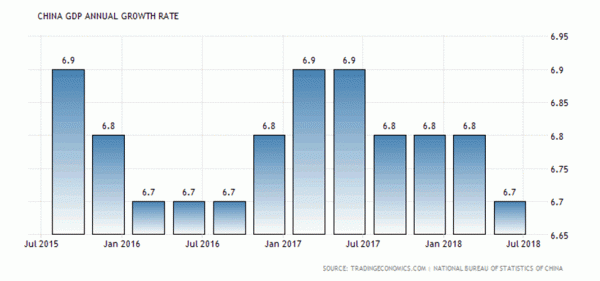China’s second-quarter GDP growth was seen advancing at a pace of 6.7% in line with estimates, official data showed last week. The second quarter GDP growth was, however, slightly below the 6.8% growth registered in the first quarter of 2018.
The slight slowdown in growth came as China’s authorities have been clamping down on rising credit risk alongside uncertainty on the trade war escalations with the United States.
The headline GDP figures did not surprise the market. However, the third quarter GDP numbers are expected to show the full impact of the U.S. trade tariffs as well as the retaliatory measures taken by China.
Investors are already bracing for a slowdown in both China and the U.S. economies. Economists, however, expect that China could take the worst hit due to the large number of jobs also affected. The U.S. hiked tariffs on steel and aluminum imports across most of its trading partners including China.
As late as July, the trade wars continued to escalate. The U.S. was seen imposing more tariffs on China. It imposed a 25% border tax on goods worth $34 billion in imports to the U.S.
Meanwhile, China retaliated by imposing tariffs on an equal amount of goods imported from the U.S.
While there were some positive developments surrounding the trade tensions with both sides appearing to reach a compromise, the optimism quickly fell following the U.S. issuing renewed threats on more trade tariffs on Chinese goods.
With rising trade tensions between the world’s first and second largest economies, the global trade is also expected to take a hit. Furthermore, the sentiment is also expected to affect the housing market in China.
Experts believe that while China remains committed to financial deleveraging, growth is also expected to slow in the coming months.
Data so far pointed to the fact that fixed asset investment during the first half of the year hit a record low of 6.0%. Industrial output for the month of June was also the slowest growth rate witnessed.
The slower economic conditions are expected to see China’s authorities ease up the monetary policy. But this would require a balancing act as the authorities continue to deleverage the financial risks.
Last week, China’s commerce ministry reported that it had filed a complaint to the World Trade Organization (WTO) regarding the newly issued threat of the U.S. imposing further tariffs on goods worth $200 billion.
While the tariffs have not yet been implemented, the U.S. authorities are expected to review the plans for two months with the hearing expected to be held in August.
U.S. officials maintain that the number of tariffs imposed was equivalent to China’s exports to the U.S. Some of the sectors taking a hit also include sectors that are part of China’s initiative of Made in China 2025.
This initiative was started with an aim to position China as a global player in the industrial sector. The initiative was however met with criticism by officials in the U.S. which later saw the nation soften its message about the initiative.
The People’s Bank of China was seen lowering the reserve requirements ratio nearly three times this year.
The GDP report comes following the previous week’s inflation and PPI numbers. Data showed that producer prices rose at the fastest pace in six years. Producer prices advanced 4.7% in June on an annualized basis. This was higher than the previous month’s increase of 4.1%.
Meanwhile, consumer prices also advanced at a pace of 1.9% which was in line with the estimates. Still, inflation is seen falling short of the 3% target that was set for this year.














